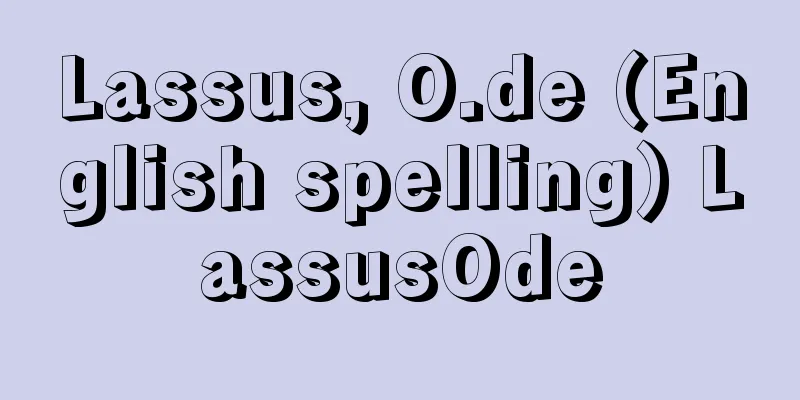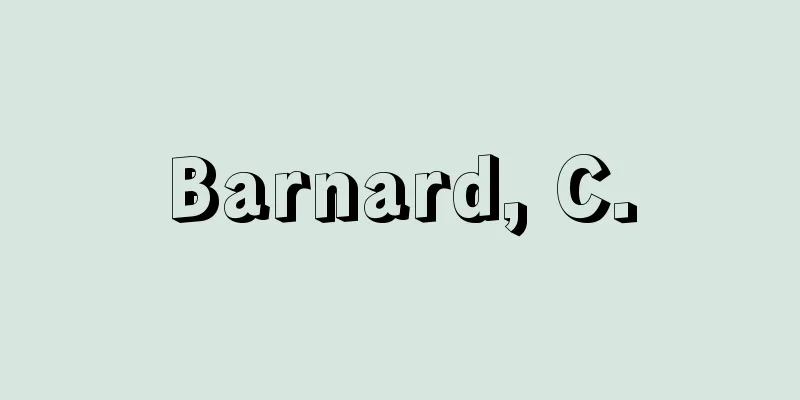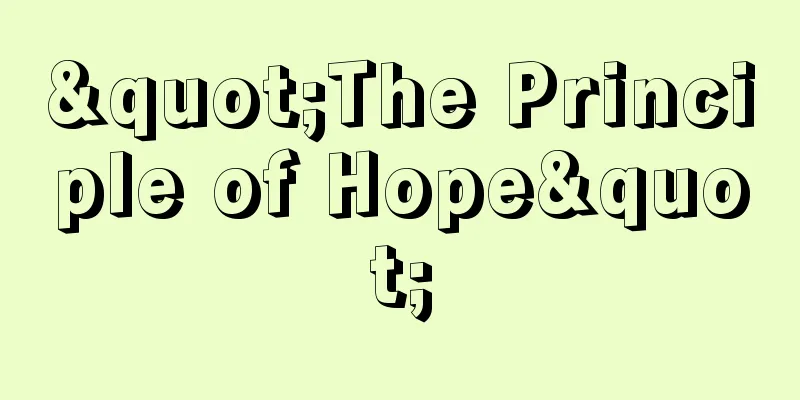Cryptography
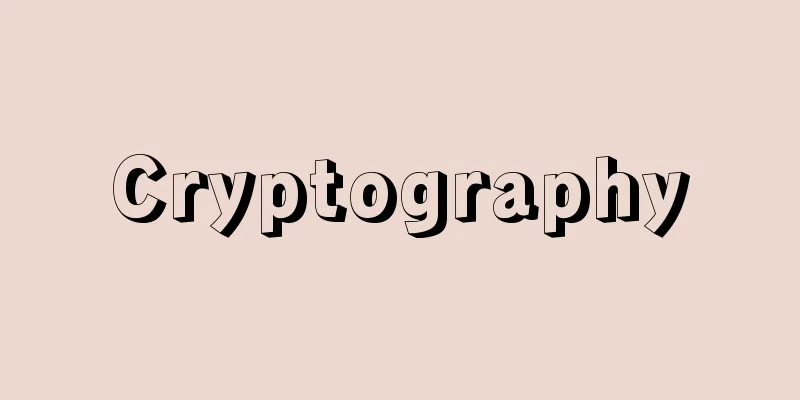
|
In a broad sense, it refers to the words and techniques used to conceal or authenticate the contents of communications. The term cipher was introduced from China, and was used to mean a password or signal until around the time of the Seinan War (1877). It generally refers to things written in text. In Japanese military books, the word equivalent to cipher is "keisakubunshitatame-sama no koto." [Nagata Junko] Principles and FormsThe principle of cryptography can be easily understood by considering the structure of language. Since a word consists of fixed sounds (letters) arranged in a fixed order, which in turn have fixed meanings, the only way to conceal it from third parties is to artificially apply certain operations to each of these language structures. These can be summarized into six types: (1) substitution, (2) transposition, (3) division, (4) set words, (5) secret writing, and (6) mixed writing. (1) Substitution This is the most commonly used form of encryption. In Europe and the United States, substitution methods are divided into ciphers and codes. A cipher is a method of replacing an original text character by character with another character or symbol. The cipher in Poe's novel "The Gold Bug" is one example. A code (abbreviation) is a replacement of a single letter, syllable, word, phrase, or sentence of various lengths with a meaningless group of letters or numbers of a fixed length. A familiar example is a postal code. A book that compiles the correspondence between words and the symbols that represent them, like a dictionary, is called a code book. (2) Transposition: There are methods such as writing in reverse order, writing the original text using a figure, and then writing it out in the other direction according to the instructions of a key to create a cipher text. In addition, an anagram such as rearranging OLD ENGLAND to make GOLDEN LAND could also be called a transposition method technically. (3) Separate Style A familiar example is the "nosa kotoba" (words with a "nosa" between the first and second syllables of a word). Another example is the "oriku" (acrostic). For example, in the poem "Ogurayama, the peaks of the mountains stand and cry, the deer growl, no one knows autumn," by Ki no Tsurayuki, the "ominaheshi" (words with a "nosa" in them) is hidden at the beginning of each line. In practice, methods such as marking the letters on a newspaper with secret ink or using a stencil with certain windows cut out are used. (4) Promises These are also called slang. The following slang terms that were revealed in connection with the Lockheed scandal are good examples.
(5) Cryptic Codes These are the most ingenious codes using metaphors. Examples include the riddles in the Nihon Shoki and nursery rhymes, and there are many cryptic riddles, such as the riddle of the Sphinx in Greek mythology. (6) Mixed ciphers: A typical example is a combination of substitution and transposition ciphers. This generally increases the strength of the cipher, but the cipher is more complicated. In detective novels, in order to create an element of surprise when solving the puzzle, a non-cipher-like cipher, such as a division cipher or a secret message cipher, is sometimes used at the end of the combination. [Nagata Junko] Basics of code breakingDeciphering a code requires not only general knowledge of the language in which the original text was written, but also basic quantitative data. Frequency is the percentage of the usage of a character. In Japanese written in kana, the frequency is highest for iunshi no yoka to kutsu, etc. These are merely statistical results, and in actual ciphers, the order changes to some extent. The frequency characteristics of characters are the most effective tool for determining not only the form of substitution and transposition, but also the various methods of ciphers, and ultimately leading to decipherment. In addition, in terms of the continuation of characters (conjunction characteristics), the order of characters is often th, he, in, er, re, etc. in English, and yo, yu, sei, tou, tei, etc. in Japanese. These characteristics are extremely effective in deciphering not only transposition but also ciphers. There are also characteristics in the frequency and conjuncture of words. Of course, this statistical survey is a difficult task, but it is indispensable for creating and deciphering code books. [Nagata Junko] History of cryptographyIt can be said that the origin of codes dates back to the time when humans first had language. In the beginning, words themselves would have been codes for those who did not know them, and paraphrases themselves would have played the role of secret writing or promises. Records of the use of general codes and cryptographic notations go back to the times of Ancient Egypt and Greece. In Greece, there are examples of transposition codes using sticks called scytales, and a table with the same structure as the "Law of 48 Letters" from the Warring States period was used to transmit letters by signal fire. In Rome, Caesar's substitution code is famous. However, the rapid progress of codes began mainly in Italy in the 14th and 15th centuries, the birthplace of modern diplomacy. Initially, tables of conventions (allegories) were used for diplomatic purposes, but gradually codes became the norm, and during the reigns of Louis XIII and Louis XIV of France, they evolved into the modern code book form. For centuries afterwards, code books were the primary method of diplomatic encryption, as well as commercial and military encryption. As it became known that ciphers could be easily decoded using only one substitution table, they were further invented, and eventually progressed to the point where each character in the original text was replaced with a different code or letter by changing the substitution table. Usually, the number of substitution tables is the same as the number of letters or codes (26 for the English alphabet, 10 for numbers), and each substitution table uses a certain regular character arrangement. Among them, the "Vigenere square table" is famous. In Europe and the United States, this method is called a multi-table method because of the number of substitution tables, but in Japan it is called a random number method (random character method) because a key is used to select the substitution table. A book containing these random numbers is called a random number table (random number book). From around the time of World War II, the two methods of code book and random number formula were used together as one encryption method. The "D cipher" of the Japanese Navy at the time of the Battle of Midway is one example. A cipher machine is a machine that mechanizes a certain system of substitution or transposition. The German Enigma and American M209 used during World War II are polymorphic in principle, and the Data Encryption Standard (DES), adopted as the encryption standard by the U.S. government in 1977, is a realization of a mixed system using advanced calculation and semiconductor technology. Incidentally, most countries now have organizations tasked with communications attack (which includes code breaking) and defense, which shows that code warfare continues to this day, both in wartime and peacetime. [Nagata Junko] Cryptography and ComputersCryptography and computers are deeply related. Even in the early days of computers, British mathematician Turing and his team completed a vacuum tube computer for code-breaking called Colossus in 1943. The nature of cryptography has been changing with the progress of computers and the development of their usage. [Kazuo Nishimura] Modern CryptographyAdvances in information theory have brought about great advances in cryptography theory. In particular, the theory published by the American Shannon in 1949 is still useful today. According to this theory, any ciphertext with more than a certain number of characters can be deciphered by some method. However, this number of characters varies depending on the encryption method and the characteristics of the language, and with a method that uses a disposable random number table, the number becomes infinite (meaning it cannot be deciphered). The theory also points out that the amount of work required to decipher the cipher (such as the number of arithmetic operations) is an important measure of the security of a ciphertext. Modern cryptography differs technically from classical cryptography in three main ways: (1) The processing unit has changed from characters to bits -- In the past, the processing of encryption (assembly) and decryption (translation) was performed on characters, but now the processing is performed on each digit (called a bit) when the character is expressed in binary code. This trend began with the appearance of the cipher machine and became more pronounced as computer processing became more common. Deciphering a cipher text that is divided into small elements such as bits is a difficult task, just like trying to reconstruct the pieces (characters) of a jigsaw puzzle (sentence) that are further divided into smaller pieces (bits). (2) The efficiency of processing has increased dramatically -- the use of computers for decryption has made trial and error easier and faster. Therefore, the encryption and decryption processes must also be made more complex using computers. (3) Security has come to depend on the amount of calculations required -- even with conventional complex encryption methods, if the method is guessed, the possibility of discovering the key to decryption increases, and it is no longer considered secure. Therefore, encryption methods that emphasize the amount of calculations required have been devised, which, although theoretically possible to decrypt, would take tens of thousands of years to actually decrypt, even with the fastest computers. [Kazuo Nishimura] DESThe American encryption standard, DES, is a modern take on classical techniques, using a 56-bit key to process (encrypt and decrypt) 64-bit data. The process consists of 16 repetitions of a single operation, with each operation using bitwise transposition, addition, and substitution. There are two types of transposition: one in which bits are duplicated to increase the number (widening transposition), and one in which several bits are removed (contracting transposition). Substitutions are made every 6 bits, reducing them to 4 bits. This is achieved by looking up a table, and this part (called an S-box) makes it particularly difficult to decrypt. The same key is used for encryption and decryption, and the process is almost the same (the only difference is whether the key is rotated clockwise or counterclockwise). [Kazuo Nishimura] Public Key CryptographyW. Diffie and ME Hellman announced a revolutionary encryption concept in 1976. Its novel feature is that the encryption and decryption keys are different, and this alone brings about various advantages. The encryption key can be made public and even published in something like a telephone directory, while the decryption key must be kept secret. Therefore, many senders can send messages encrypted with the same key to a certain receiver. Moreover, only the receiver who has the secret key can decrypt the message. This eliminates the need to secretly exchange specific keys between senders and receivers. Also, the number of keys that each individual needs to keep secret when communicating in a group is reduced from the number of people who previously needed to keep the same number of keys. If the encryption and decryption processes work in reverse, it is also possible to create a signature. That is, the original message is encrypted using a (private) decryption key, and the recipient uses the public encryption key to decrypt it to recover the original message. Since only someone with the private decryption key can create this message, it has the same effect as signing (or stamping). Thus, two parties can exchange signed secret messages if they each know the other's encryption key. Signatures are important to prevent interception by an adversary, and as evidence in commercial transactions. When Diffie and Hellman announced the concept of public key cryptography, no concrete method had been devised yet, and it was merely a pie in the sky, so to speak, but various concrete methods have been proposed since then. Some methods apply number theory, performing calculations on the remainder of division by large integers. This is called calculation under the modulus, and for example, if the modulus is 60, then 127mod60=7. A representative method is the RSA method, and to decrypt it, a large integer (200 digits) must be decomposed into prime factors, which is nearly impossible (it would take one million years even if one hundred million calculations were performed per second). In addition to the RSA method, there are also methods that allow only secret communication, methods that allow only signatures, and methods that allow only key determination for use with DES, etc. Public key cryptography has come to be used for e-mail, electronic money, and so on. [Kazuo Nishimura] In 1999, DES was decrypted using multiple computers. To improve security, Triple DES was devised, which repeats DES three times. Later, an encryption technology called AES (Advanced Encryption Standard) appeared as a successor to DES. This is more secure than DES because it uses a maximum data length of 256 bits, and was adopted as the standard encryption method in the United States in 2001. Other encryption methods include RSA, which is widely used on the Internet, and FEAL (Fast Data Encipherment Algorithm), developed by NTT. [Editorial Department] "Cryptography" by Nagata Junko (1979, Diamond Inc.) " ▽ "Computer Science" (a supplement to "bit", 1980, Kyoritsu Shuppan)" ▽ "Cryptographic Wars" by David Kahn, translated by Hata Ikuhiko and Sekino Hideo (Hayakawa Bunko)" ▽ "The Mathematics of Cryptography" by Ichimatsu Makoto (Kodansha Bluebacks) [References] | | | |Original text...the die is cast Cipher text...WKH GLH LV FDVW ©Shogakukan Caesar (Caesar) Original text...a good glass...cipher text...5 3‡‡† 305)... ©Shogakukan Substitution table for Poe's The Gold Bug Original text: Toyotomi (Toyotomi) Code: 17 31 17 66 ©Shogakukan The 48 Laws of Character Changes (Warring States Period) Note: The assembly table is in alphabetical order in the original language, while the translation table is in numerical order. Please compare the blue section [051 Our Army]. ©Shogakukan "> Example of a code book Original text: The enemy fleet is in sight. It appears the enemy is heading for the eastern channel. (The code is written in kana, and punctuation marks are omitted.) Code text: TEIHAIKANTESHINIYO KIMIHIDO TAKISUMUU KAYUGAUMO ©Shogakukan Example of key-type geometric transposition Original text...the die is cast Key...DOG DOG DO GDOG Ciphertext...WVK GWK LG IDGZ ©Shogakukan Vigenere square table (multiple tables) ©Shogakukan "> Overview of DES encryption The receiver transmits the product of two prime numbers, n, and an arbitrary number, e, to the sender via a general communication channel. The sender encrypts it using n and e, but only the receiver who knows the prime factorization of n can decrypt it. RSA takes advantage of the fact that it is extremely difficult to factorize large numbers, n . Public Key Cryptography (Overview of the RSA Method) Source: Shogakukan Encyclopedia Nipponica About Encyclopedia Nipponica Information | Legend |
|
広い意味では、通信の内容を秘匿(ひとく)したり認証するために使うことば、ならびにその技術。暗号という用語は中国から入ったもので、西南戦争(1877)ごろまでは、合いことばもしくは合図といった意味に使われた。一般的には、文字で書かれたものを対象にしている。日本の兵法書には、暗号に相当することばとして「計策文認(したた)め様の事」とある。 [長田順行] 原理と形式暗号の原理は、ことばの仕組みを考えてみるとよくわかる。ことばは、決まった音(文字)が決まった順序に並び、それが決まった意味をもつわけであるから、これを第三者に秘匿する方法は、このようなことばの仕組みの一つ一つに、ある操作を人為的に加えること以外にはない。これをまとめると、(1)換字(かえじ)式、(2)転置式、(3)分置式、(4)約束語、(5)隠文式、(6)混合式の六つの形式となる。 (1)換字式substitution もっともよく使われる暗号の形式である。その方法を、欧米ではサイファーcipherとコードcodeに分ける。サイファーとは、原文を文字単位に別の文字や符号で置き換えるものをいう。ポーの小説『黄金虫(こがねむし)』の暗号文はその一例である。コード(略号)とは、単一の文字、音節、単語、句あるいは文のように各種各様の長さのものを、一定の長さの無意味な文字群または数字群で置き換えたものをいう。身近なものには郵便番号がある。語句とそれを表す記号の対応を辞書のように一冊にまとめたものをコード・ブック(暗号書)という。 (2)転置式transposition 逆順に書く方法、図形を利用して原文を書き込み、別の方向に鍵(かぎ)の指示によって順次に書き出して暗号文とするといった方法などがある。なお、OLD ENGLAND(老いたるイギリス)を並べ替えて、GOLDEN LAND(黄金の国土)にするといったアナグラムも技法的には転置式とよべなくもない。 (3)分置式 身近な例には、単語の第1音節と第2音節の間に「ノサ」の2音を挟む「ノサことば」がある。また、折句(おりく)(アクロスティック)などもそうである。たとえば、紀貫之(きのつらゆき)の「小倉山 峯(みね)立ち鳴らし なく鹿(しか)の へにけむ秋を しる人ぞなき」という和歌には、各句の初めに「おみなへし」が隠されている。実際には、新聞の文字に秘密インキで印をつけるとか、一定の窓を切り抜いた型紙を使うなどの方法が用いられる。 (4)約束語 隠語ともよばれる。ロッキード事件に関連して明らかにされた、以下のような隠語の数々はそのよい例である。
(5)隠文式 比喩(ひゆ)を使ったもっとも巧緻(こうち)性に富む暗号。『日本書紀』の諷歌(そえうた)や童謡(わざうた)の例もそうであるし、ギリシア神話のスフィンクスの謎(なぞ)かけなど、なぞなぞには隠文式のものが多い。 (6)混合式 代表的なものは、換字式と転置式の組合せである。一般的に強度は増すが、暗号作業は複雑となる。推理小説では、解決の意外性をねらう目的から、分置式や隠文式などのような暗号らしくない暗号を、組合せの最後に使うことがある。 [長田順行] 暗号解読の基礎資料暗号の解読には、原文に使われた国語の一般的な知識のみならず、計量的な基礎資料が必要である。 文字の使われる割合を百分率で示したものを頻度という。仮名で書いた日本語では、いうんしのよかとくつ……といった順に頻度が高い。これらはあくまでも一つの統計結果であって、実際の暗号文では、その順位はある程度変わる。文字の頻度の特徴は、換字式と転置式の形式判定のみならず、サイファーの各種の方式を判定し、最終的な解読に至るもっとも有力な武器となる。また、文字の続きぐあい(連接特徴)では、英語の場合は、th, he, in, er, re,……の順に、日本語では、よう、ゆう、せい、とう、てい、……の順によく使われる。これらの特徴は、転置式のみならずサイファーの解読にもきわめて有効である。単語についても、その頻度や連接には特徴がある。もちろん、この統計調査はたいへんな作業であるが、コード・ブックの作成、あるいは解読には欠かすことができない。 [長田順行] 暗号の歴史暗号の起源は、人類がことばをもったときから始まるといってよい。初めはことばそのものが、それを知らない人にとっては暗号であったであろうし、言い換えそのものが、隠文式や約束語としての役割を果たしたであろう。一般的な暗号を使った例や暗号記法について述べた記録は、古代エジプトやギリシアの時代まで下らなければならない。ギリシアでは、スキュタレーとよぶ棒を使った転置式の暗号の例があるし、戦国時代の「字変四十八の法」と同じ構成の表が、のろしによる文字の伝送に使われている。ローマでは、カエサルの換字式の暗号が有名である。しかし、暗号の急激な進歩は、近代外交の発祥地である14~15世紀のイタリアを中心に始まる。 当初は、約束語を表にしたもの(隠語表)が外交用に使われたが、しだいにコードがその主流となり、フランスのルイ13世、14世の治下では現在のコード・ブックの形態まで進歩した。それから何世紀もの間、コード・ブックは外交用暗号はもちろん、商業用暗号や軍事用暗号の主要な方式となった。 サイファーは、一つの換字表を使っただけでは簡単に解読されることが知られるにつれて次々にくふうされ、最終的には、原文の一つ一つの文字を換字表を変えながら別の符号や文字に置き換えるところまで進歩した。通常、換字表の数は文字や符号の数と同じ(英語ではアルファベット26、数字ならば10)で、それぞれの換字表は一定の規則的な文字配列のものが使用される。なかでも「ビジュネルの正方形の表」は有名である。この方式は、欧米では換字表の数に着目して多表式とよばれるが、日本では換字表の選択に鍵(かぎ)を使うところから乱数式(乱字式)とよぶ。この乱数を一冊にまとめたものが乱数表(乱数帳)である。第二次世界大戦のころから、コード・ブックと乱数式の二つの方式はあわせて一つの暗号方式として使われるようになる。ミッドウェー海戦当時の日本海軍の「D暗号」もその一例である。 暗号機というのは、換字式や転置式のある方式を機械化したものである。第二次世界大戦中に使用されたドイツのエニグマやアメリカのM209は、原理的には多表式であるし、1977年にアメリカ政府の暗号規格として採用されたDES(デズ)暗号Data Encryption Standardは、混合式を、進歩した計算技術と半導体技術によって具体化したものである。 なお、現在では、ほとんどの国が通信攻撃(暗号解読もその一つ)と通信防衛を任務とする組織をもっている。このことは、戦時、平時を問わず、暗号戦争がいまもなお続いているということを物語っている。 [長田順行] 暗号とコンピュータ暗号とコンピュータは深く関与している。コンピュータの揺籃(ようらん)時代にも、イギリスの数学者チューリングらが1943年に完成させた暗号解読用の真空管計算機(コロッサスColossus)があった。コンピュータの進歩とその利用形態の発達により暗号の様相も変化してきている。 [西村和夫] 近代的な暗号技術情報理論の進歩は暗号の理論を飛躍的に進歩させた。とくにアメリカのシャノンが1949年に発表した理論は、現在でも役にたっている。その理論によれば、ある文字数以上の暗号文は、なんらかの方法によって解読されてしまう。ただしこの文字数は、暗号の方式と言語の特性によって異なり、使い捨ての乱数表を用いた方式では無限大になる(つまり解読できない)。また、暗号の安全性の尺度として、解読に要する作業量(四則演算の回数など)が重要であることも指摘している。 現代的な暗号が古典的な暗号と技術的に異なるおもな点は次の三つである。 (1)処理単位が文字からビットになった――暗号化(組立て)と復号(翻訳)の処理において、古くは文字を操作の対象にしていたが、文字を二進符号で表したときの各桁(けた)(ビットという)を対象とするようになった。この傾向は暗号機の登場によって始まり、コンピュータでの処理が盛んになるとともに顕著になった。ビットのように細分化した要素についての暗号文の解読は、たとえばジグソー・パズル(文章)の一片(文字)をさらに細かく刻んだもの(ビット)を復原しようとするのと同じように、困難な作業となる。 (2)処理の能率が大幅にあがった――暗号解読にもコンピュータを利用することで、試行錯誤が手軽にかつ高速に行えるようになった。そのため、暗号化や復号の処理もコンピュータを使ってより複雑なものにしなければならない。 (3)安全性を計算量に拠(よ)るようになった――従来の複雑な暗号でも、その方式を推定されると、解読の鍵(かぎ)を見破られる可能性が大きくなり、安全とはいえなくなった。したがって、解読が原理的には可能でも、実際に解読しようとすると、最高速のコンピュータを使っても何万年もかかるような、計算量を重視した暗号が考案されている。 [西村和夫] DESアメリカの暗号規格であるDES方式は古典的な手法を現代的な思想で集成したもので、56ビットの鍵を用い、64ビットのデータを処理(暗号化と復号)する。処理は16回の単一操作の繰返しからなり、各操作での手法として、ビット単位の転置と加算および換字を行う。転置には、ビットを重複させて数を増やすもの(拡大転置)と、数ビットを削減するもの(縮小転置)とがある。換字は6ビットごとに行い、4ビットに縮小する。これは表を引くことで実現され、この部分(S箱という)がとくに解読を困難にしている。暗号化と復号には同一の鍵を用い、処理もほぼ同じである(違うのは、鍵の回転を右回りにするか左回りにするかだけである)。 [西村和夫] 公開鍵暗号ディフィーW. DiffieとヘルマンM. E. Hellmanは1976年に画期的な暗号の構想を発表した。その斬新(ざんしん)な点は、暗号化と復号の鍵を異なったものにすることで、これだけのことで、さまざまな長所が生じる。復号の鍵は秘密にしなければならないが、暗号化の鍵は公開して電話帳のようなものに載せることさえできる。したがって、多数の送信者が、ある受信者に同一の鍵で暗号化した通信文を送ることができる。しかもそれを復号できるのは、秘密の鍵を隠しもっている受信者だけである。これによって、特定の鍵を送受信者の間でひそかにやりとりする必要がなくなる。また、集団のなかで交信するときに各個人が秘密に保管しなければならない鍵の数も、いままでは交信する人の数だけ必要であったのが、各自の復号用の鍵だけですむ。 もし暗号化と復号の処理が、逆に組み合わせてもうまく働くならば、署名をすることもできる。つまり、原文を(秘密の)復号用の鍵を使って暗号化した通信文にして送り、受け取ったほうは公開されている暗号化用の鍵を使って復号することによって原文に戻すのである。この通信文をつくれるのは秘密の復号の鍵をもっている人だけなので、署名(つまり捺印(なついん))したのと同じ効果がある。したがって、二者が互いに相手の暗号化の鍵を知っていれば、署名付きの秘密通信を交わすこともできる。署名は、敵による攪乱(かくらん)を防いだり、商取引上の証拠とするために重要である。 ディフィーとヘルマンが公開鍵暗号の構想を発表したときには、まだ具体的な方式が考案されず、いわば絵にかいた餅(もち)だったが、その後いろいろな具体的方式が提案されている。いくつかの方式は整数論を応用したもので、大きな整数による割り算の余りに関する演算を行う。これを法modulusのもとでの演算といい、たとえば60を法とすれば127mod60=7となる。この代表的な方式としてRSA法があり、これを解読するには大きな整数(200桁)を素因数分解しなければならないが、それはほぼ不可能である(毎秒1億回の演算をしても100万年かかる)。RSA法のほかにも、秘密の通信だけができる方式、署名だけができる方式、さらにDESなどで用いる鍵の決定だけができる方式などもある。公開鍵暗号は電子メールや電子マネーなどに使われるようになってきた。 [西村和夫] 1999年に複数台のコンピュータを使ってDESが解読された。そこでより安全性を高めるため、DESを3回繰り返すトリプルDESが考案された。 その後、DESの後継としてAES(Advanced Encryption Standard)という暗号化技術が登場した。これは、最大256ビットのデータ長を使うためDESよりも安全性が高く、2001年にはアメリカの標準暗号方式として採用された。そのほかに、インターネットで広く使われるRSAやNTTが開発したFEAL(Fast Data Encipherment Algorithm)などもある。 [編集部] 『長田順行著『暗号』(1979・ダイヤモンド社)』▽『『コンピュータ・サイエンス』(『bit』別冊・1980・共立出版)』▽『デイヴィッド・カーン著、秦郁彦・関野英夫訳『暗号戦争』(ハヤカワ文庫)』▽『一松信著『暗号の数理』(講談社・ブルーバックス)』 [参照項目] | | | |原文……the die is cast暗号文…WKH GLH LV FDVW©Shogakukan"> カエサル(シーザー)の換字表 原文……a good glass……暗号文…5 3‡‡† 305))……©Shogakukan"> ポー『黄金虫』の換字表 原文……と よ と み (豊臣)暗号文…一七 三一 一七 六六©Shogakukan"> 字変四十八の法(戦国時代) 注:組立表は原語が五十音順、翻訳表は数字順。青色部分[051 我ガ軍の]欄を比較のこと©Shogakukan"> コード・ブック(暗号書)の例 原文……敵艦隊見ゆ。敵は東水道に向かう模様(暗号用にすべてカナにし、句点などを省略)暗号文…テイハイカ ンテシニヨ キミヒドウ タキスムウ カユガウモ©Shogakukan"> 鍵式図形転置の例 原文……the die is cast鍵………DOG DOG DO GDOG暗号文…WVK GWK LG IDGZ©Shogakukan"> ビジュネルの正方形の表(多表) ©Shogakukan"> DES暗号の概要 受信者は二つの素数の積nおよび任意の数eを一般通信路で送信者に伝える。送信者はnおよびeを用いて暗号化するが、これを解読できるのはnの素因数分解を知っている受信者だけである。RSAは大きなnの素因数分解がきわめてむずかしいことを利用したものである©Shogakukan"> 公開鍵暗号(RSA法の概要) 出典 小学館 日本大百科全書(ニッポニカ)日本大百科全書(ニッポニカ)について 情報 | 凡例 |
<<: Secret Inspector - Anglerfish Inspector (English: amhaeng-ǒsa)
>>: Anglerfish (Anglerfish) - Anglerfish (English spelling) goosefish
Recommend
Sarumata (monkey thigh) - Sarumata
Short pants-style underpants for men with a genero...
Tekomai - Tekomai
These were people who sang Kiyari songs and parad...
Trivet - Trivet
〘Noun〙① The five elements that make up all things ...
Anyafil - Anyafil
...The technique is often depicted in Persian, Tu...
Scirpus maritimus (English spelling) Scirpus maritimus
...A perennial plant of the Cyperaceae family tha...
Theory of Depravity - Darakuron
A critical essay by Sakaguchi Ango. Published in S...
Ye Lai Shan
Night jasmine. A climbing shrub of the Asclepiadac...
Ordinary chondrite
...Iron meteorites, stony-iron meteorites, and ac...
Dried malt
Malt is dried and stored. The enzyme activity is s...
sudden outbreak
…Also called an abnormal outbreak. There are two ...
Glass filter
...There are two methods for separating precipita...
manas
…In ancient India, the word manas (translated int...
Twelve points of opinion
This is a sealed opinion submitted to Emperor Daig...
Hagedorn, AL
...The random change in gene frequency due to the...
spike-wave stupor
…Recently, it has become relatively easy to treat...

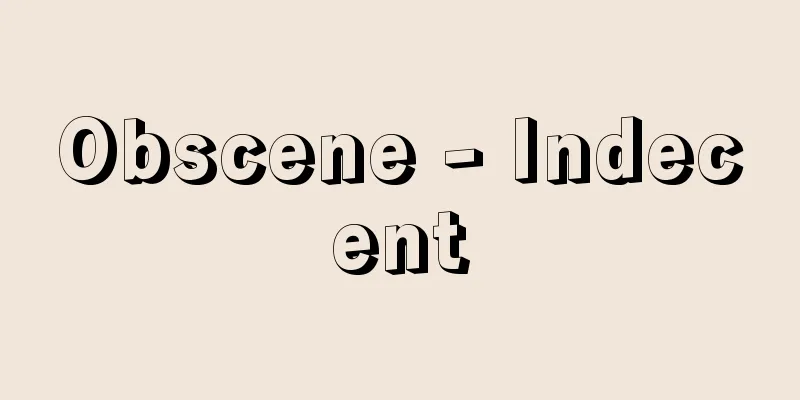
![Nishio [city] - Nishio](/upload/images/67cc6c7fcaabb.webp)



